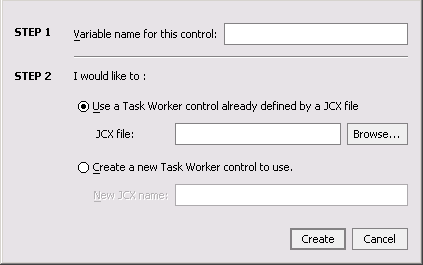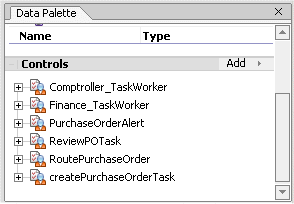Creating a New Task Worker Control
The Task Worker control allows specified users to acquire ownership of Tasks, work on them, and complete them. It also provides administrative privileges, such as starting, stopping, deleting, and assigning. Access to the Task Worker control can be done with a business process or through a user interface (UI). You can customize each Task worker control for different business purposes.
This topic describes how to create a new Task Worker control. Task Worker controls do not have any properties to configure.
- Open your WebLogic Integration application in WebLogic Workshop
- If you are not in Design View, click the Design View tab.
- On the Data Palette, in the Controls tab, click Add —> Integration Controls. A list of controls representing the resources with which your business process can interact is displayed.
Note: If the Controls tab is not visible, from the menu bar, click View —> Windows —> Data Palette.
- Choose Task Worker. The Insert Task Worker dialog box is displayed.

- In the Insert Control dialog box (Step 1), enter a name for the instance of this control. The name you enter must be a valid Java identifier.
- In the Insert Control dialog box (Step 2), select one of the following options:
- To use a Task Worker control already defined by a JCX file, in the JCX file field, enter a filename for the Task Worker control, or click Browse to find the JCX file in your file system.
- To Create a new Task Worker control to use, in the New JCX name field, enter a filename.
- Click Create to close the Insert Control dialog box.
When you click create, the control JCX file is displayed in the Application tab. In both Design and Source View, you can double-click any JCX file to view or edit it. The instance of the control is displayed on the Controls tab of the Data Palette.
- To display the base methods provided for the control instance, click the + beside its name on the Data Palette. The following figure shows an example of a Task Worker control instance displayed on the Controls tab in the Data Palette.

- After you create an instance of the Task control in your business process, you can design the interaction of the business process with the Task control by simply dragging and dropping the Task control methods from the Data Palette onto the Design View at the point in your business process at which you want to design the interaction.
For examples of designing interactions between a business process and an instance of a Task control, see Using Task and Task Worker Controls in Business Processes.

|

|



